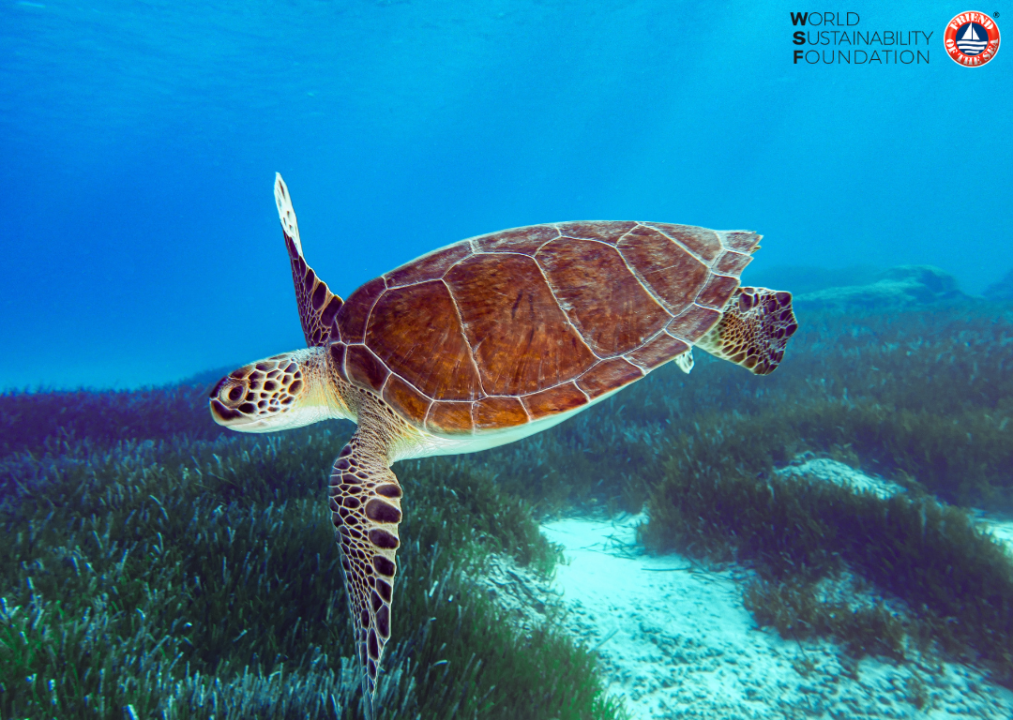World Sea Turtle Day is observed on June 16th annually, this year Friend of the Sea and the World Sustainability Foundation give you a window into the world of the fascinating Green Sea Turtle.
Come along, while we discover the largest sea turtle species belonging to the Chelonidae family, and the only living species in the genus Chelonia.
To start off, the name Green Sea Turtle originated from its greed for sprouts and sea plants, such as seagrasses, as a result its feeding habit determines its green body colour.
It’s quite a challenge to spot the Green Turtle in the Mediterranean Sea. However, some have managed to document its presence in the Gulf of Manfredonia and Sardinia. Its habitats are tropical and sub-tropical, the most significant nesting areas are the Caribbean Coast of Costa Rica and Australia’s Great Barrier Reef.
Unfortunately, in spite of its intriguing features the Green Sea Turtle, known scientifically as Chelonia mydas is classified as an “endangered species” by the International Union for Conservation of Nature (IUCN); and the first culprit to threaten the green turtle’s existence, is humans.
Activities such as bycatch fishing, beach tourism at nesting sites, and habitat pollution are the main threats to the green turtle’s survival.
Friend of the Sea, a project of leading global sustainability organization, the World Sustainability Organization, has developed measures to protect and preserve the lives of Green Sea Turtles. For more information on how to get involved, visit our webpage –
Now, here are some surprising facts and latest news about the Green Sea Turtle to mark World Sea Turtle Day!
What makes the Green Sea Turtle so unique?
⁃ The Green Turtle is the biggest sea turtle species member of the family Chelonidae, and it’s the only specie alive of the genus Chelonia.
⁃ The animal can reach 140 cm in length and weigh up to 130Kg!
⁃ Green Sea Turtle is distinguished from other sea turtles by the absence of a beak, which forms the protrusion at the end of the mouth present in other sea turtles.
⁃ The upper part (carapace)of the Green Turtles shell has 4 pairs of costal or lateral scutes, and a pair of scales between the eyes, known as prefrontal scales.
⁃ The carapace colour pattern is olive brown, with yellow or marbled streaks and spots, while the ventral area is white or white-yellow. Young specimens are uniformly brown olive, with the limbs bordered yellow.
⁃ The scales of the Green Sea Turtle don’t overlap, unlike other sea turtles.
NUTRITION
The diet of the Green Sea Turtle changes as it ages; the young specimens feed on jellyfish, shellfish and little organisms, while the older specimens feed mainly on plants such as marine phanerogams. For this reason, older specimens can be found in areas rich in submerged prairies. Green turtles also have a preference for younger leaves, due to the high proteins and low fibers; making them easily digestible.
REPRODUCTION
The Green Sea Turtle reaches sexual maturity between the ages of 25 to 40 years, during which the adult searches for its own mating area. The reproductive period lasts from late spring to early summer. Female turtles mate and lay about 140 eggs at night every 2-4 years.
Incubation lasts for 2 months and once the eggs have hatched, the newborns quickly reach the sea following visual stimuli, as the sea tends to be brighter than sand dunes.
Sex determination of newborn depends on soil temperature; incubation temperatures close to 32 °C produce only females, temperatures close to 26 °C produce only males and 29 °C produces approximately the same number of females and males.
Once carried into the waters, the young specimens will have to provide for themselves. Transported by the oceans currents, they are limited in growth until possessing the ability to overcome the currents and swim to the neritic zone.
WHERE DOES THE GREEN TURTLE LIVE?
The Green Turtle is typically found in tropical and sub-tropical areas. It’s also present in the Mediterranean Sea, but in Italy it’s sporadically found in the Gulf of Manfredonia and in Sardinia. In addition, they can be found in the Atlantic, Pacific and Indian Ocean and Black Sea.
The largest nesting areas are the Caribbean Coast of Costa Rica, where on average about 22.000 females congregate, and the Australian Great Barrier Reef, where the reproductive population is estimated at 18.000.
The migratory movements aren’t well established, but this specie is capable of covering vast distances. Usually, during the day these specimens swim on surface water while at night they prefer long dives.
CONDITION AND MAIN THREATS
Currently, Chelonia mydas is classified as vulnerable for the IUCN red list of threatened species. Threats include bycatch, trapping in fishing nets, bathing tourism at nesting sites and coastal lighting, as well as habitat contamination caused by plastic objects thrown into the sea which are often swallowed by the turtles, accumulating in their stomach or causing suffocation.
Another major threat is global warming, leading to imbalances in newborns due to altering temperatures, resulting in unpredictable sex determination.
Additionally, the Green Turtle is commercially viable in some locations, with its meat, eggs, skin and shell in great demand. Interestingly, since the seventeenth century the green turtle has served as a staple in turtle soup, known as a delicious accompaniment. Although the trade is illegal in Asia, green turtle meat and eggs is said to increase potency, resulting in its high consumption.
Fortunately, today there are numerous associations that control and protect reproductive sites. A wider information and awareness-raising campaign for fishermen is crucial, to educate them on using less invasive fishing nets and share handling methods on board vessels, in order to reduce post-catch mortality. Friend of the Sea® makes an invaluable contribution with the “Turtle Safe” Project, by imposing specific standards on fishing companies to reduce the catches of these astonishing animals and ensure their conservation.
Congratulations, you’ve almost completed your exploration of the world of Green Sea Turtles, now here are some fun facts!
5 FUN FACTS ABOUT THE GREEN TURTLE
– Green Turtles have a herbivorous diet based on sea plants, contributing to the color of the animal’s body fat, deriving the name ‘’Green Turtle’’.
– The development of the Green Sea Turtle is dependent on its geographical location, as it is closely linked to the plant sources found in its habitat. A study on a Green Turtle in Hawaii, where its favorite plants are in abundance, detected a sexual maturity at the age of only 11 years!
– It’s believed that Chelonia mydas is one of the few species to have seen Dinosaurs evolve and become extinct! In fact, the ancestors of turtles progressed on earth and adapted to marine life about one hundred and fifty million years ago.
– The contour of the mouth of these specimens is notched; precisely to enable it snatch the seaweed effectively.
– You must have seen the cartoon ‘’Finding Nemo’’, well did you know that the turtles featured are Green Sea Turtles?
Now you’ve learnt all there is to know about the Green Sea Turtle, join us at Friend of the Sea® by supporting the Turtle Safe Project, as we ensure the unique Green Turtle is protected for the posterity of our planet.




